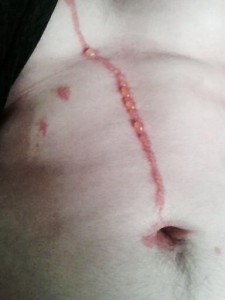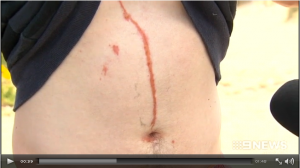Welcome to Our Summer Interns!
Meet Grayson and Grace—two of our outstanding summer interns at the Ohio History Connection!
 Australian Dylan Maxwell recently reported that a tropical spider burrowed into his skin, leaving a foot-long wound going up his chest. There are a few problems with his story, some of which I covered in my last post, but let’s stick to the pictures.
Australian Dylan Maxwell recently reported that a tropical spider burrowed into his skin, leaving a foot-long wound going up his chest. There are a few problems with his story, some of which I covered in my last post, but let’s stick to the pictures.
First, the wound. It looks like a long, skinny burn mark–as if someone ran the end of a hot knife down his chest. It’s actively oozing lymph, and there are other reddened areas adjacent to the scar. The unmarked skin has a general reddish flush.
Here’s the same wound a couple weeks later, after it’s healed somewhat: Although some people are indeed allergic to spider venom, which can cause localized swelling and itching and sometimes the release of lymph fluid at the bite site, no known species of spider burrows into living tissue or creates a track like this. It’s possible that it was some other kind of arachnid, but I have my doubts.
Although some people are indeed allergic to spider venom, which can cause localized swelling and itching and sometimes the release of lymph fluid at the bite site, no known species of spider burrows into living tissue or creates a track like this. It’s possible that it was some other kind of arachnid, but I have my doubts.
So if it wasn’t a spider, any other kind of arachnid, what made this distinctive wound? Probably the same thing that did this!
Although this case is much worse than Dylan’s, we see a similar pattern here of long, skinny dark red marks and localized swelling. Still stumped? Another clue is that this happened in Bali in early October. If you were in Bali, what would you do? Go to the beach, perhaps? If you’ve spent any time in tropical Pacific waters, this sign will be a familiar sight:
Box jellyfish are particularly deadly because they are not only large, but also venomous. The stinging cells (nematocysts) in their tentacles contain a chemical that causes blood vessels to leak potassium, which can ultimately cause cardiac arrest if enough venom is injected.
It probably wasn’t a box jelly that stung him, but the waters of Bali do have them, as well as smaller species of jellyfish that also cause a raised blister and lifelong scarring (warning: link not for the faint of heart!). A jellyfish sting causes immediate burning pain, which varies in severity depending on the species and the amount of skin affected. The stung skin initially appears somewhat reddened and swollen, like a mosquito bite, but fluid-filled blisters appear within 24 hours and the painful wound oozes lymph. As it heals, a dark scar forms.
What’s surprising is that the Australians haven’t picked up on this yet, or at least suggested that it’s a possibility. October through May is widely known to be “stinger season” along the tropical coasts of the country, and many people choose to avoid the water altogether. Even a disembodied piece of tentacle–probably what happened in Dylan’s case–can cause a painful sting.
Hopefully Dylan will get back to us soon with details about what the doctors removed from his body. I’m just as curious as you are, but as of this posting the internet seems to have forgotten all about it. Maybe its some kind of tiny burrowing beach crustacean. Or maybe, despite the millions of visitors that Balis beaches get every day, it is in fact a species of flesh-eating spider that has been heretofore unknown to science.
Or maybe he just got stung by a jellyfish.
Congrats to Mike for guessing correctly!